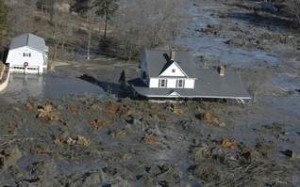On Dec. 22, 2008, a billion gallons of sludge covered 300 acres, and spilled into the Clinch and Emory Rivers when the retention pond burst at the Tennessee Valley Authority’s Kingston Steam Plant. That’s 1,000,000,000 gallons of toxic soup containing Arsenic, Lead, Mercury, Selenium and other toxics and carcinogens. Tennessean.com, Knoxvillebiz.com.

View of what had been the James Home, Copyright (c) 2008, Knoxville Biz . com
Robert F. Kennedy, Jr.’s law firm, Kennedy, Madonna, LLP, and the Levin Papantonio Law Firm have joined to investigate the Tennessee Coal Spill on behalf of property owners living in the impacted area. For more information call 888-435-7001 or click here.
According to TVA spokesman Gilbert Francis, “Most of that material is inert. It does have some heavy metals within it, but it’s not toxic or anything.” However, according to the EPA, coal fly ash and sludge contains carcinogens and high concentrations of heavy metals. Furthermore, “concentrations of arsenic to which people might be exposed through drinking water contaminated by fly ash could increase cancer risks several hundredfold” AP, NYTimes, Yahoo.
Coal plants in the US produce 129 million tons of fly ash per year. 129 million tons! This is the number two largest waste stream in the U. S., second to municipal solid waste. The amount of fly ash is increasing as air pollution control technology is being deployed. Scrubbers and other hardware are designed to burn coal in ways that produce less air pollution. However the pollutants that are not released into the atmosphere must go somewhere.
Solar and wind farms produce zero grams of solid waste, zero grams of radioactive waste, and zero grams of greenhouse gases per year. Offshore wind farms produce artificial reefs, which are good for the environment. But in reality, Clean Coal does not exist. (“We Shall Not Be Moved” listen / lyrics )